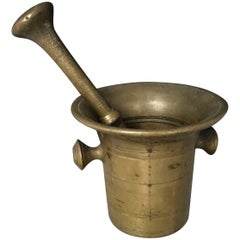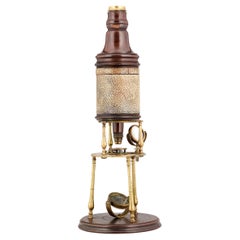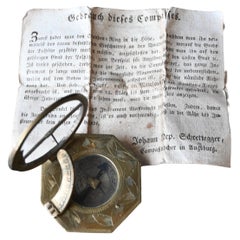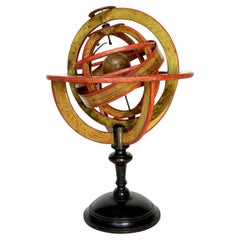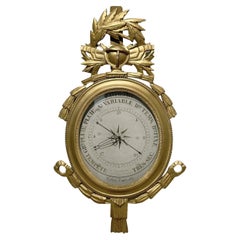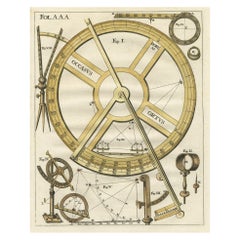18th Century Scientific Instruments
to
11
66
33
100
20
16
4
4
1
1
1
1
135
603
835
9
389
297
60
28
44
36
39
32
54
37
22
10
57
53
25
19
19
89
33
29
24
8
100
100
100
3
2
1
1
1
Period: 18th Century
Antique Hand-Crafted Solid Bronze Mortar with Pestle and Great Original Patina
Located in Lisse, NL
Decorative and tactile, late 18th century mortar set.
Mortars have been used for centuries by private people and by people in certain trades. In the kitche...
Category
European Antique 18th Century Scientific Instruments
Materials
Bronze
Culpeper Compound Microscope
Located in New Orleans, LA
Compound Monocular Microscope
Edmund Culpeper
Circa 1730
This extraordinary early 18th-century microscope is a museum-worthy example of scientific innovation and craftsmanship made ...
Category
English Antique 18th Century Scientific Instruments
Materials
Brass
$48,500
Rare 18th Century Equatorial Sundial And Compass By Johann Nepomuk Schrettegger
Located in Bilzen, BE
"Rare 18th Century Equatorial Sundial And Compass By Johann Nepomuk Schrettegger,"
Rare 18th-Century Equinoctial Sundial & Compass by Johann Nepomuk Schrettegger, Augsburg
Maker: Joh...
Category
German Louis XVI Antique 18th Century Scientific Instruments
Materials
Brass
Ptolemaic Armillary Sphere, Charles-François Delamarche, Paris, ante 1798
Located in Milano, IT
Ptolemaic armillary sphere
Charles-François Delamarche
Paris, ante 1798
Wood and papier-mâché
covered with printed and partly hand-colored paper
It measures 16.37 in in height x Ø 10.94 in (41.60 cm - Ø 27.80 cm)
It weights 2.33 lb (1,058 g)
State of conservation: consistent with its age and use, the paper shows some signs of use, stains and abrasions.
The sphere is Ptolemaic, with the Earth placed at its center, surrounded by the Moon and the Sun mounted on two metal arms.
The sphere is composed of six horizontal and two vertical rings (armillae), each bearing graduations and its own name.
The first horizontal ring is illegible. The others, in descending order are: North Pole, Tropic of Cancer, Equator, Tropic of Capricorn, South Pole.
The vertical rings consist of two double meridians.
The sphere is then connected to the large meridian by two pins, a vertical ring inserted perpendicularly into the circle of the Horizon, in turn supported by four semicircles connected to the turned and black-stained wooden base.
Each element is covered with printed paper. It contains various pieces of information: latitudes, length of days, names and zodiac symbols, calendar, wind directions, etc.
The vertical circles mention the latitudes and longitudes of different cities: Rome, Bordeaux, Madrid, Boston, Batavia (Jakarta), Acapulco, etc.
Even the small terrestrial globe is covered with printed paper: continents and oceans appear with numerous geographical markings indicating the most recent explorations.
In the Pacific Ocean, west of South America bears the following inscription:
GLOBE
TERRESTRIAL
à Paris
chez Delamarche Géog
Rue du Foin Jacques
Au Collège de
M.e Gervais
The North American coasts are well delineated and California appears correctly as a peninsula - reports from Spanish explorers in the region had given rise to confusion as to whether it was connected to the mainland or not. The geographical nature of California was confirmed after the explorations of Juan Bautista de Anza (1774-1776).
Alaska is not described and is only partially traced; it would become part of the United States in 1867.
Various Pacific islands are indicated.
Australia (the name definitely used from 1824) is called "Nouvelle Hollande."
Tasmania is still represented as a peninsula and this is an important detail for the dating of our armillary sphere.
The island is separated from Australia by Bass Strait, which was crossed by Matthew Flinders for the first time in 1798, showing that it was not a peninsula. Delamarche certainly would not have waited a long time to update such an important geographical datum: presumably he did so shortly after receiving the news.
Charles-François Delamarche (1740-1817) founded his laboratory around 1770 and, in a few years, he became the most famous French cartographer and globe maker between the 18th and 19th centuries. After having acquired the laboratory of the late Didier Robert de Vaugondy (1723-1786; himself a renowned cartographer who continued the family business founded by his grandfather Nicolas Sanson in the seventeenth century) and after having purchased, between 1788 and around 1800, the businesses of Jean-Baptiste Fortin (1750-1831) and Jean Lattré (around 1750-1800), he began to call himself "Successeur de MM. Sanson and Robert de Vaugondi, Géographes du Roi and de M. Fortin, Ingénieur-mécanicien du Roi pour les globes et les sphères."
Thus, at the end of the eighteenth century, Delamarche possessed the warehouse stocks, as well as the manufacturing skills of the globes of his main rivals in Paris.
In addition to this aggressive acquisition policy, the key to its success also lay in the combination of high-quality cartography combined with extremely attractive globes and armillary spheres; and, of course, its famous red paint finishing touch.
His laboratory was located on Rue de Foin St Jacques "au Collège Me. (or "Mtre") Gervais" in the Latin Quarter of Paris until around 1805, when he moved to rue du Jardinet No. 13.
On the death of Charles-François in 1817, the reins of the company passed to his son Félix (1779-1835), who continued to publish, often in collaboration with the engraver Charles Dien, Sr. In 1835 the company first moved to rue du Jardinet No. 12 and a little later to rue du Battoir No. 7.
Bibliography:
Dekker, Elly, et al. Globes at Greenwich...
Category
French Other Antique 18th Century Scientific Instruments
Materials
Wood, Paper
18th Century French Louis XVI Period Gilded Barometer by Evangelista Torricelli
By Evangelista Torricelli
Located in West Palm Beach, FL
A gold, large antique French Louis XVI period barometer, signed by Torricelli in gilded wood and of oval shape with original scientific illustrations, in good condition. The detailed wall décor piece is consisting its original glass. Framed with gilt foliate trim and important pediment. Minor fading, due to age. Wear consistent with age and use, circa 1750, France.
The Italian scientist Evangelista Torricelli...
Category
French Louis XVI Antique 18th Century Scientific Instruments
Materials
Giltwood
Occasus Ortus: An Astronomical Measuring Device for Angular Precision, c.1780
Located in Langweer, NL
This print, titled "Occasus Ortus", showcases a highly detailed engraving of an 18th-century measuring device, likely related to astronomy or navigation.
The design features various components of the instrument arranged systematically, with each part labeled by figure numbers. The centerpiece is a large circular protractor...
Category
European Antique 18th Century Scientific Instruments
Materials
Paper
$301 Sale Price
20% Off
English Pocket Globe, London, Circa 1775-1798
By Herman Moll
Located in Milano, IT
Pocket globe
London, between 1775 and 1798
Re-edition of the globe of Hermann Moll (1678-1732) dated 1719
The globe is contained in its original case, which itself is covered in shark skin.
There are slight gaps in the original paint on the sphere. The case no longer closes.
The sphere measures 2.7 in (7 cm) in diameter whereas the case measures 2.9 in (7.4 cm) in diameter.
lb 0.22 (kg 0.1)
The globe is made up of twelve printed paper gores aligned and glued to the sphere.
In the North Pacific Ocean there is a cartouche with the inscription:
A Correct
Globe
with the new
Discoveries.
The celestial globe is depicted on the inside of the box and is divided into two hemispheres with the cartouche:
A correct globe
with ye new cons
relations of Dr.
Halley & c.
It shows the ecliptic divided into the days of the zodiacal calendar and the constellations represented as animals and mythological figures.
On the globe are delineated the equinoctial line, divided by degrees and hours, the ecliptic and the meridian (passing west of Greenwich). The continents are shaded and outlined in pink, green and yellow. It shows: the Cook routes; a wind rose in the Southern Indian Ocean; Antarctica without land; Africa with Negroland (Hermann Moll is considered the first geographer to name the West African region in his 1727 map. (Encyclopaedia Britannica, ed. 1902, under "States of Central Africa"); Tartary in Central Asia; the Mogul kingdom in northern India; in North America only New England, Virginia, Carolina, Florida, Mississippi are identified; California is already a peninsula; the northwest coast of America is "unknown parts" (Alaska is not described and it is only partially delineated, it was to become part of the United States in 1867); Mexico is named "Spain"; Central South America "Amazone America". Australia (which was to be so named after 1829) is called New Holland. The route of Admiral Anson is traced (1740) and the trade winds are indicated by arrows. (See Van der Krogt, P., Old Globes in the Netherlands, Utrecht 1984, p. 146 and Van der Krogt, P. - Dekker, E., Globes from the Western World, London 1993, pp. 115.)
Elly Dekker, comparing Moll’s 1719 globe and his re-edition (of which the one described above is a sample), identifies the differences between them: the two editions are quite similar to each other, but in the "anonymous" globe, compared to the previous globe of 1719, California looks like a proper peninsula - the reports of the Spanish explorers of the region had given rise to uncertainty over whether it was connected to the mainland or not. The geographical nature of California was confirmed after the explorations of Juan Bautista de Anza (1774-1776). The routes of Dampier's journey were partially erased and the route of Captain James Cook's first voyage was superimposed on them, and the geography of Australasia was adapted accordingly, including the denomination of the Cook Strait. See Dekker, Elly, Globes at Greenwich, 1999.
An important ante quem element is represented by Tasmania: it is not separated from Australia by the Bass Strait...
Category
English George III Antique 18th Century Scientific Instruments
Materials
Shagreen, Paper
Ptolemaic Armillary Sphere, Charles-François Delamarche, Paris, ante 1798
Located in Milano, IT
Ptolemaic armillary sphere
Charles-François Delamarche
Paris, ante 1798
Wood and papier-mâché
covered with printed and partly hand-colored paper
It measures 15.55 in in height x Ø 10...
Category
French Other Antique 18th Century Scientific Instruments
Materials
Wood, Paper
A Fine Adams, London Culpepper Microscope
Located in Lincolnshire, GB
A late 18th century brass lacquered Culpepper design microscope by Adams, London in the original mahogany case. The two drawers contain a good selection of lenses and accessories.
Th...
Category
English Antique 18th Century Scientific Instruments
Materials
Brass
18th Century Diptych Portable Sundial And Compass by German Beringer
Located in Milano, MI
Antique 18th Century Diptych Sundial and Compass a portable wooden boxwood sundial with compass, of German origin, by David Beringer, Nuremberg, dating back to the 1790 circa, in good age related condition, with signs of wear consistent with age and use.
David Beringer (1756 – 1821) was a German scientific instrument maker and craftsman active in Nuremberg and famous for his cubic wooden sundials visible in Metropolitan Museum of Art di New York.
A portable sundial...
Category
German Antique 18th Century Scientific Instruments
Materials
Brass
18th Century mahogany and brass telescope by Nairne & Blunt of London
Located in Martlesham, GB
18th Century mahogany and brass telescope by Nairne & Blunt of London, having a mahogany barrel with a thumb wheel to the side of the main barrel, supported on a solid brass tripod s...
Category
British Georgian Antique 18th Century Scientific Instruments
Materials
Mahogany
Gustavian brass box with perpetual calender based on the rune staff
Located in Knivsta, SE
Gustavian brass box with perpetual calender based on the rune staff. The box is from the late 18th Century and was used as a perpetual calendar and...
Category
Swedish Gustavian Antique 18th Century Scientific Instruments
Materials
Brass
Mechanical Equatorial Sundial, Johann Michael Bergauer, Ante 1745
By Johann Michael Bergauer
Located in Milano, IT
Johann Michael Bergauer (Simonsfeld, 1676 - Innsbruck, 1745 circa)
Mechanical equatorial sundial
Signed: Michael Bergauer Insprugg? Innsbruck?
Ante 1745
Gilded and silvered brass; glass.
Measures: closed 1.29 x 3.50 x 4.92 in (33 x 89 x 125 mm); open 5.19 x 3.50 x 3.81 in (132 x 89 x 97 mm).
Weight: the sundial 0.49 lb (224 g); the case 0, 20 lb (95 g)
Original wooden case covered in brown leather.
State of conservation: very good. It has some signs of use. The spring that allowed for the two parts of the instrument to remain open is missing (absent even in the comparative specimens kept in museums).
The sundial is composed of two overlapping plates hinged together on the north edge.
The base plate is octagonal and is supported by three turned legs. The upper face is gilded and a compass with a magnetic variation index has been inserted. The rest of the surface is occupied by a rich decoration of engraved scrolls, centered around the inscription “Michael Bergauer Insprugg”. A foldable oval support with a plumb-bob is attached with a hinge on the southern edge. On the reverse of the base plate a table of the latitudes of some European cities (expanded with the vertical writing “Meiland 40” on the edge and “Rome” deleted) and of Jerusalem has been engraved. A Cam marked for 0 °-70 ° is applied near the northern edge. This can be adjusted to change the inclination of the upper plate according to the latitude; originally a spring, now lost, made it possible to keep the two plates of the clock open.
The second plate is round, has a toothed edge and measures 3.26 in (83 mm) in diameter: it is slightly smaller than the octagonal base which it rests upon and overlaps when the instrument is closed.
The recto is gilded and there are three concentric graduated circles engraved on it:
- the outermost is the equatorial hour dial, numbered I-XII, I-XII;
- the second-one is that of days 1-30 of the lunar month and has “Aetas lunae” engraved on it;
- the third, silvered, is a subsidiary hour dial, with double numbering 1-12; originally it could have been rotated.
The engravings of the first two circles are enameled in red.
In the center - on the polar axis - there is an alidade, at the end of which is associated the silvered minute dial. This, in turn, is welded, perpendicularly, to a small disc, also silvered, with a triangular gnomon. The plate, alidade and minute dial are connected to each other by toothed mechanisms.
Below is the procedure for measuring the time:
1) Adjust the Cam under the base of the clock, based on the latitude of your location;
2) Place the watch on a flat surface using the plumb-bob and with the side closest to the compass facing south;
3) Keeping the instrument still, manually rotate the alidade until the shadow cast by the triangular gnomon on the small silvered disc falls on the line marked below it;
4) The hour and minutes can therefore be read on the hour and minute dials set on the alidade respectively.
Johann Michael Bergauer, who sometimes only signs his works as Michael Bergauer, was born in Simonsfeld, north of Vienna. His apprenticeship as a watchmaker took place in Landshut and he probably worked as a laborer in Augsburg before becoming a watchmaker at the court of Karl Philipp von der Pfalz in Innsbruck in 1708. In the following years, his repeated attempts to obtain Innsbruck citizenship are documented and, in 1721, he is listed as a resident. In 1724 he was admitted to the guild of watchmakers, with which however he had continuous problems. In 1732 he presented a "masterpiece". This is the last reference to his business; he must have died before or in 1745 because in that year his widow appealed to the City Council.
The mechanical sundial...
Category
Austrian Baroque Antique 18th Century Scientific Instruments
Materials
Brass
English Mahogany Steel Engraved Stick Barometer Signed F. Tarone, Circa 1780
Located in Charleston, SC
English mahogany stick Barometer with a broken arch pediment, brass urn finial, Satin wood string inlay, hinged glass door revealing a numeral steel engraved dial with original mounted thermometer and barometric pressure gauge. Signed F. Tarone. Late 18th Century Barometer...
Category
English Sheraton Antique 18th Century Scientific Instruments
Materials
Steel
French 18th Century Balance Scale
Located in Round Top, TX
A handsome French 18th century balance scale in iron and brass. The balance mechanism is in iron. The foot and the plates are in brass. The...
Category
French Antique 18th Century Scientific Instruments
Materials
Brass, Iron
Late 18th Century Lacquered Brass Table Telescope
Located in Huntington, NY
Late 18th century lacquered brass table telescope.
Category
English George III Antique 18th Century Scientific Instruments
Materials
Brass
$4,368 Sale Price
20% Off
Antique Three-Draw Telescope, English, Walnut, Brass, Navigation, Georgian, 1790
Located in Hele, Devon, GB
This is an antique three-draw telescope. An English,walnut and brass navigational or astronomical instrument by Lincoln of London, dating to the Georgian period, circa 1790.
Perfect...
Category
British Georgian Antique 18th Century Scientific Instruments
Materials
Brass
Spanish 18th Century Mortar and Pestle
Located in Round Top, TX
A very handsome 18th century mortar and pestle hand carved from a solid block of wood. Sensational patina. A wonderful object for table top, bookca...
Category
Spanish Antique 18th Century Scientific Instruments
Materials
Wood
Antique 18th Century Diptych Portable Sundial And Compass by Beringer
Located in Bilzen, BE
Antique 18th Century Diptych Sundial and Compass a portable wooden sundial with compass, of German origin, by David Beringer, Nuremberg, dating back to the 1780 circa, in good age re...
Category
German Louis XVI Antique 18th Century Scientific Instruments
Materials
Metal
Antique Mortar and Pestle Duo, English, Brass, Apothecary, Jardiniere, Georgian
Located in Hele, Devon, GB
This is an antique mortar and pestle duo. An English, polished brass apothecary dish or decorative jardiniere pot, dating to the Georgian period, circa 1800.
Dashing Georgian morta...
Category
British Georgian Antique 18th Century Scientific Instruments
Materials
Brass
Celestial Table Globe, Charles-François Delamarche, Paris, 1791
Located in Milano, IT
Celestial table globe
Charles-François Delamarche
Paris, 1791
It measures: 17.13 in in height, Ø max 27.7 in; the sphere Ø 7.09 in
(h 43.5 cm x Ø max 27.7 cm; the sphere Ø 18 cm).
W...
Category
French Other Antique 18th Century Scientific Instruments
Materials
Metal
Pocket Globe by Nathaniel Hill, London 1754
Located in Milano, IT
Nathaniel Hill
Pocket globe
London, 1754
The globe is contained in its original case, which itself is covered in shark skin.
There are slight gaps in the original paint on the sphere. The case no longer closes.
The sphere measures 2.6 in (6.8 cm) in diameter whereas the case measures 2.9 in (7.4 cm) in diameter.
lb 0.24 (kg 0.11)
The globe is made up of twelve printed paper gores aligned and glued to the sphere.
In the North Pacific Ocean there is a scroll with the inscription:
A
New
terrestrial
Globe
by
Nath. Hill,
1754.
The celestial globe is depicted on the inside of the box.
On the terrestrial globe much of central and southern Africa is empty. North America bears only the name of some British colonies. It shows California as a peninsula and the northwest coast of America as "unknown parts" (Alaska is not described and is only partially delineated; it would become part of the United States in 1867). The route of Admiral Anson is traced (1740) and the trade winds are indicated by arrows. Australia, still named New Holland (the new name would be introduced in 1829), is part of the west coast. (See Van der Krogt, P., Old Globes in the Netherlands, Utrecht 1984, p. 146 and Van der Krogt, P. - Dekker, E., Globes from the Western World, London 1993, p. 115.)
Nathaniel Hill (London, news from 1746 to 1768) had impeccable professional credentials: he had done his apprenticeship with Richard Cushee, who at the time was carrying out surveying work for John Senex's Surrey map...
Category
English George II Antique 18th Century Scientific Instruments
Materials
Shagreen, Paper
18th Century Carpenters Hand Plane Tool, Signed and Dated 1791
Located in Haddonfield, NJ
Rare Museum-level 18th Century carpenters tool, an antler hand plane, hand-carved to look like a lion. Signed with initials and dated 1791.
Category
Scandinavian Folk Art Antique 18th Century Scientific Instruments
Materials
Metal
$1,400 Sale Price
56% Off
Travel pharmacy in mahogany wood and brass, England 1790.
Located in Milan, IT
Travel pharmacy. Box in Mogano Sipo ( Entandrophragma utile ) wood and brass with recessed handles on both sides and a drawer on the front. The upper level opens, inside it there are...
Category
English Antique 18th Century Scientific Instruments
Materials
Brass
A 18th-Century scientific instrument: wooden screw dilator clamp.
Located in Milan, IT
A medical instrument. A brass screw clamp (dilator), with a rosewood handle. It consists of two symmetrical parts, each with a circular cushion element that continues with a cylindri...
Category
English Antique 18th Century Scientific Instruments
Materials
Brass
18th Century English Treen Yew Wood Mortar and Pestle
Located in Stamford, CT
18th century English treen mortar and pestle hand turned and carved from yew wood with the rich and warm patina that only comes with age and use. Beautifully carved by hand from a si...
Category
English Georgian Antique 18th Century Scientific Instruments
Materials
Yew
George III Mahogany Banjo Barometer Edinburgh
Located in Huntington, NY
George III Mahogany Banjo Barometer By Edie & Son. Edinburgh
Alexander James Adie FRSE MWS (7 November 1775, Edinburgh – 4 December 1858, Edinburgh) was a Scottish maker of medical ...
Category
English George III Antique 18th Century Scientific Instruments
Materials
Brass
: Wooden pocket diptych sundial Ernst Christoph Stocket. Germany 1780 - 1811.
Located in Milan, IT
Wooden pocket diptych sundial Ernst Christoph Stocket - type, Bavaria. A folding wooden sundial is partially covered in paper with engraved/printed decorations and text. A compass is...
Category
German Antique 18th Century Scientific Instruments
Materials
Wood, Paper
Brass Gregorian refractor telescope circa 1750 attributed to James Short
Located in Milan, IT
Antique mid-18th-century brass Gregorian refractor telescope, almost certainly made by James Short (1710-1768). Good condition, replaced eyepiece and missing lens, lathe rebuilt the ...
Category
Antique 18th Century Scientific Instruments
Materials
Brass
A trunk style travel apotecary cabinet in mahogany wood and brass, England 1790.
Located in Milan, IT
English travelling apothecary made of mahogany Sipo mahogany (Entandrophragma utile) and brass with a rectangular base, a front drawer, an opening to...
Category
English Antique 18th Century Scientific Instruments
Materials
Brass
Antique Original Engraving of Seasons by Le Bas, C.1780
Located in Langweer, NL
Antique astronomy print titled 'L'inégalité des Saisons et des Jours'. Interesting print explaining why there is an inequality in the length of days and seasons. Source unknown, to b...
Category
Antique 18th Century Scientific Instruments
Materials
Paper
$301 Sale Price
20% Off
French Louis XVI Barometer
Located in Queens, NY
French Louis XVI (18th Century) barometer with original scientific illustrations and mercury vial framed with gilt foliate carvings & ebonized ...
Category
French Louis XVI Antique 18th Century Scientific Instruments
Materials
Giltwood, Glass
Antique Kitchen Mortar & Pestle, English, Bronze, Apothecary, Chemist, Georgian
Located in Hele, Devon, GB
This is an antique kitchen mortar and pestle. An English, bronze apothecary or chemist's shop aid, dating to the Georgian period, circa 1780.
Useful kitchen or apothecary aid from ...
Category
British Georgian Antique 18th Century Scientific Instruments
Materials
Bronze
Portable Copying Machine by James Watt & Co.
By James Watt
Located in New Orleans, LA
Considered the first step into the world of modern photocopying, the copying machine was among the first widely used devices to successfully produce an ex...
Category
English Other Antique 18th Century Scientific Instruments
Materials
Mahogany
Stick Barometer Mahogany Board Antique Weather Measuring Instrument J. Ramsden
By Jesse Ramsden
Located in Milan, IT
Stick barometer mounted on a mahogany board complete with vernier reading the variation of atmospheric pressure signed by Jesse Ramsden, end of the 18th century.
Very good condition...
Category
Antique 18th Century Scientific Instruments
Materials
Wood
Italian 18th Century Balance, Scale
Located in Round Top, TX
A very stunning 18th century balance - Scale from Rome, Italy. Beautifully crafted from polychromed and gilt wood. A wonderful accent piece for a library or office.
Category
Italian Antique 18th Century Scientific Instruments
Materials
Wood
Antique Engraving of Constructing Sun Dials, 1769
Located in Langweer, NL
Antique print of Ferguson's method of constructing sun dials. This print originates from 'The Gentleman's Magazine'.
Artists and Engravers: The Gentleman'...
Category
Antique 18th Century Scientific Instruments
Materials
Paper
$122 Sale Price
20% Off
Weather in Style: Exquisite 18th-Century French Barometer by Charles Desnioulin
Located in New York, NY
This exquisite 18th-century French barometer, crafted in 1778 by Charles Desnioulin (Signed), is a true masterpiece of both science and art. The finely carved wood frame, adorned wi...
Category
French Louis XVI Antique 18th Century Scientific Instruments
Materials
Wood, Glass
George III Oversized Magnifying Glass Late Circa 1790
Located in Bishop's Stortford, GB
George III Oversized Magnifying Glass Late Circa 1790. Comprised of a turned mahogany surround holding 20 cm lens with a turned mahogany handle connected by a generous brass ferrule ...
Category
European George III Antique 18th Century Scientific Instruments
Materials
Brass
John Bennett Georgian Barometer
By John Bennett
Located in New Orleans, LA
This exceptional Georgian barometer by the leading London instrument-maker John Bennett strongly reflects the prevalent furniture style and archite...
Category
English Georgian Antique 18th Century Scientific Instruments
Materials
Brass
18th Century Gregorian Brass Telescope By Springer Of Bristol
Located in Lincolnshire, GB
A fine 3" Gregorian telescope by Springer of Bristol, although signed this model is very similar to examples we have had by George Adams and could have been made by him for Springer ...
Category
English Antique 18th Century Scientific Instruments
Materials
Brass
Sundial and Compass with Case, Schrettegger, Johan, Augsburg, Germany, Ca 1800
Located in Madrid, ES
Sundial and compass with case. Bronze. SCHRETTEGGER, Johan. Augsburg, Germany, around 1800.
Sundial with a polygonal shape made of bronze, engraved with plant elements on the front,...
Category
German Neoclassical Antique 18th Century Scientific Instruments
Materials
Bronze, Other
18th Century Medical Syringe
Located in London, GB
18th Century Medical Syringe
For historical medical use and dating from the 18th century, and certainly from the beginning of the 18th century. This hand-crafted example is made to...
Category
Unknown Antique 18th Century Scientific Instruments
Materials
Natural Fiber
Italian-transalpine time dial paper on wood board. Giusti, Nerici, Italy 1781.
Located in Milan, IT
An Italian and transalpine hour dial in paper printed on a fruitwood board. The base, in turned boxwood, has a wavy profile and distinct edge, at the top of which is mounted the rect...
Category
Italian Antique 18th Century Scientific Instruments
Materials
Brass
Late 18th Century French Giltwood Barometer
Located in Essex, MA
Period late 18th century giltwood barometer. Original gilding. Carved overall with globe, and navigation instruments. Foliate and neoclassical motifs. Maker signed.
Category
French Louis XVI Antique 18th Century Scientific Instruments
Materials
Giltwood
18th Century George Sterrop Cuff Type Microscope in Original Mahogancy Case
Located in Lincolnshire, GB
A fine 18th century cuff type microscope by Sterrop, London
The microscope stands on a mahogany base with single drawer fitted with a near complete set of accessories.
A very simil...
Category
English Antique 18th Century Scientific Instruments
Materials
Mahogany
18th Century English Mahogany Cased Stick Barometer by Dolland of London
By Dolland
Located in Dublin, IE
An exceptional late 18th century mahogany cased stick barometer by Dolland of London, The mahogany case of a very solid construction and with a superbly made turned mahogany cistern ...
Category
English Georgian Antique 18th Century Scientific Instruments
Materials
Steel
French 18th Century Mortar and Pestle
Located in Round Top, TX
A sensational 18th century mortar and pestle in iron with its base constructed from a solid block of walnut. A stunning sculpture for any tradition...
Category
French Antique 18th Century Scientific Instruments
Materials
Iron
Sundial with Compass and Case, Bronze, Bion, Nicholas, Paris, 18th Century
By Nicholas Bion
Located in Madrid, ES
Sundial with compass and case. Bronze. BION, Nicholas. Paris, 18th century.
Polygonal sundial with a bird-shaped gnomon and engraved triangular piece, which presents, on one side, ...
Category
French Neoclassical Antique 18th Century Scientific Instruments
Materials
Bronze, Other
Bronze Weight, 18th Century
Located in Madrid, ES
Weight of the 18th century. Bronze.
Bronze weight, incomplete, with the container glass and two of the smallest, all decorated in cold with incised and...
Category
European Neoclassical Antique 18th Century Scientific Instruments
Materials
Bronze
18th Century Stick Barometer by Nairne London
Located in Lincolnshire, GB
An elegant 18th century satinwood and ebony stick barometer by Edward Nairne, London.
Nairne was a famous 18th century scientific instrument and barometer...
Category
English Antique 18th Century Scientific Instruments
Materials
Ebony, Satinwood
Compass with Pocket Sundial, with Case, Bronze, Butterfield, Michael '1635-1724'
Located in Madrid, ES
Compass with pocket sundial, with case. Bronze. BUTTERFIELD, Michael (1635-1724). Paris, circa 1700.
Pocket sundial made of engraved metal, with a gno...
Category
French Neoclassical Antique 18th Century Scientific Instruments
Materials
Metal, Bronze, Other
18th Century French Giltwood and Ebonized Barometer with Floral Crest
Located in New York, NY
A magnificent 18th-century French barometer showcasing a masterful combination of giltwood and ebonized wood. The elegant frame features intricate hand-carved detailing, including a ...
Category
Antique 18th Century Scientific Instruments
Materials
Wood
A GERMAN ANATOMICAL MODEL OF a PREGNANT WOMAN STEPHEN ZICK
Located in Madrid, ES
A GERMAN ANATOMICAL MODEL OF A PREGNANT WOMAN STEPHEN ZICK
The woman with articulated arms, removable torso revealing internal organs, lying on a couch with cushion incised and modelled with simulated lace.On a later wood box.
Stephen Zick was one of a dynasty of carvers active from the late 16th to the 18th century in Nuremberg, . Such models, as well as carved skulls, were conceived as teaching tools and were inspired by the drawings of Andrea Vesalius...
Category
Antique 18th Century Scientific Instruments
Materials
Wood
18th Century French Louis XVI Carved Giltwood Wall Barometer & Thermometer
Located in Dallas, TX
Decorate a wall with this elegant, antique barometer with attached thermometer. Crafted in Paris, France, circa 1760 and hexagonal in shape, the scientific instrument features its or...
Category
French Louis XVI Antique 18th Century Scientific Instruments
Materials
Glass, Giltwood, Parchment Paper
Louis XVI Gilt-Wood Barometer & Thermometer, France c. 1780
Located in Atlanta, GA
A Louis XVI Period Barometer & Thermometer Combination, originating in France & dating from the last quarter of the 18th century. The workings enclosed by a gilt-wood case with carve...
Category
French Louis XVI Antique 18th Century Scientific Instruments
Materials
Glass, Giltwood
Important Georgian Mahogany Mercury Stick Barometer by Stott, Dumfries
Located in Norwich, GB
Fine Georgian mahogany bow fronted stick barometer. Bow fronted glass set in front of the silvered register plate with sliding vernier controlled by an ivory turned knob. Concertina ...
Category
English Georgian Antique 18th Century Scientific Instruments
Materials
Mahogany, Ivory
French 18th Century Louis XVI Period Giltwood Barometer Thermometer
Located in West Palm Beach, FL
An elegant and extremely decorative French 18th century Louis XVI period giltwood barometer thermometer. The most decorative barometer thermometer retains its original glass pane enc...
Category
French Louis XVI Antique 18th Century Scientific Instruments
Materials
Giltwood
Lignum Vitae Treen Vices Pair of Minature Tree of Life
Located in BUNGAY, SUFFOLK
- Collector's specimens
- Lignum vitae is sought after for the beauty of its grain, coloring, patina, density and toughness
Translated from Latin, vignum vitae means “wood of lif...
Category
English George II Antique 18th Century Scientific Instruments
Materials
Wood
Rare George III Celestial Pocket Globe by Cary, London
By Cary
Located in Oxfordshire, United Kingdom
A fine and rare 3" celestial pocket globe by G & W Cary, Strand, London circa 1791, housed in its original sharkskin case.
A companion globe to terrestrial globes of this type we...
Category
English George III Antique 18th Century Scientific Instruments
Materials
Plaster
Recently Viewed
View AllMore Ways To Browse
Antique Metal Wood Planes
Antique Syringes
Antique Wooden Grinder
Surveyors Box
Used Dental Instrument
Vintage Molecular Model
Barometer Lyre
Binoculars Midcentury
Wax Anatomical Model
1960s Barometer
Antique Butcher Scale
Antique Laboratory Scales
Antique Pharmacy Scales
Antique Porcelain Thermometer
Antique Weather Forecast
Art Deco Barometers
Computing Scale
Japanese Binoculars
